#Grigori Efimovich Rasputin
Text
As mentioned by the wonderful @foreverinthepagesofhistory, there exists an anecdote about Tatiana Nikolaevna's wig falling off in 1913 and her running to hide from everyone out of embarrassment. This comes from the book 'Four Sisters' by Helen Rappaport:
"One day, when she was playing a skipping game in the park with Maria Rasputin and some young officers from the Corps de Pages, Alexey’s dog had run up to her barking; Tatiana got her foot caught in the rope, tripped and as she fell ‘her hair suddenly tumbled down and, to our amazement, we saw a wig drop off’, Maria recalled. Poor Tatiana ‘revealed to our eyes and those of the two embarrassed officers, the top of her head where a few short, sparse hairs were just beginning to grow’. She was absolutely mortified, and ‘with one bound she was on her feet, had picked up her wig and dashed towards the nearest clump of trees. We saw only her blushes and vexation and she did not appear again that day.’"
Rappaport references Matryona 'Maria' Rasputina's book 'Real Rasputin' here. I unfortunately cannot find this version of her memoirs anywhere online (I think she wrote about three, and 'Real Rasputin' was her first), so I sadly can't check the actual quote for any more information.
If I'm being entirely honest, I don't know how much I believe this. Neither Olga nor Maria Nikolaevna's diaries from 1913 ever mention Rasputin's children Matyrona (Maria), Dmitri, or Varvara visiting them for fun and games, though they do talk about sometimes being in their company.
'After dinner [I] played, at Papa's request, religious things [music] and everyone went to Anya's where Father Grigori's entire family was present: Paraskovia, Feod[orovna], Mitya, Matryona, and Varya... and Zhenya.' - Olga's diary, Christmas day 1916
It's also important to note that Maria believed in Anna Anderson for a time, and a common criticism for those who supported her claim was that they didn't actually know the family well at all, so she might have put this anecdote in her book to try and combat this. Knowing that Tatiana wore a wig might have added to this supposed closeness she was trying to convince readers of.


Her memoirs have been questioned time and time again as to how accurate they actually are - she tries to paint her father, Grigori Rasputin, as having been framed for the downfall of tsarism, and she believes him entirely innocent of the various allegations against him. There are more inconsistencies. For example, in her memoirs she writes degradingly about Felix Yusupov (who was involved in the murder of her father), then named her two dogs 'Youssou' and 'Pov' after him... Also, the cover of her memoirs are quite funny, it reminds me of a bad film poster lol, but that is besides the point.


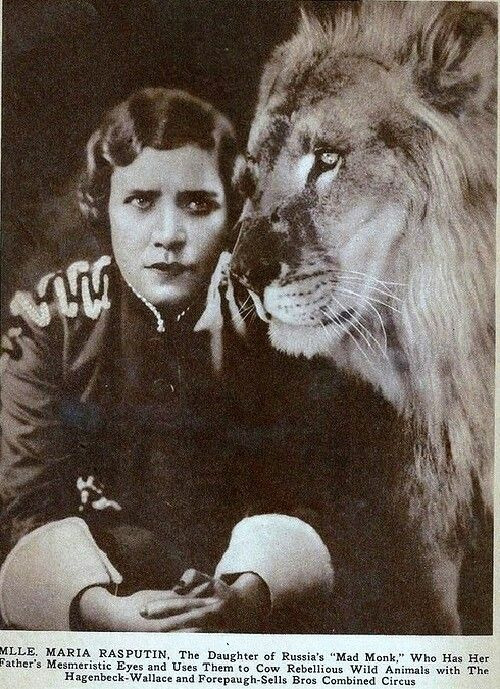
Also, Tatiana's album has photos of her posing on the Standart and on the beach with her wig off, which might suggest she was at least a little comfortable showing her shaved head to some people, like her favourite officers. When OTMA had their heads shaved in 1917, they also posed for various photographs and found it funny, not embarrassing - but it could be argued that was because they were going through it together, rather than Tatiana being the 'odd one out'.
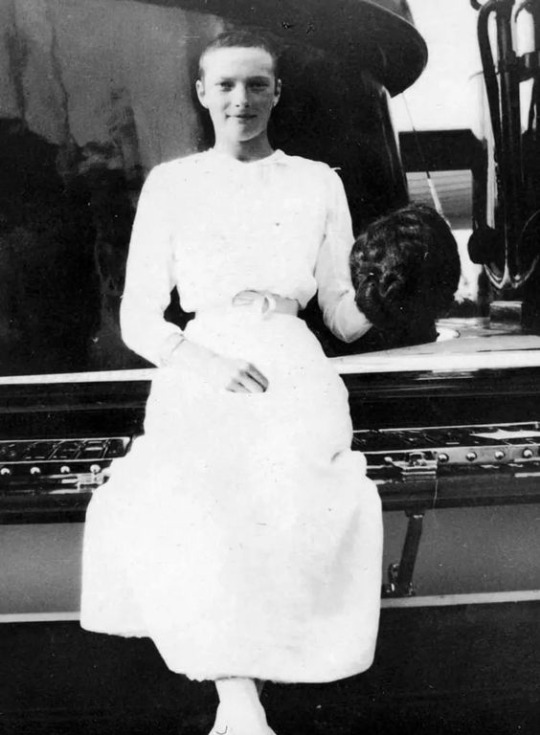



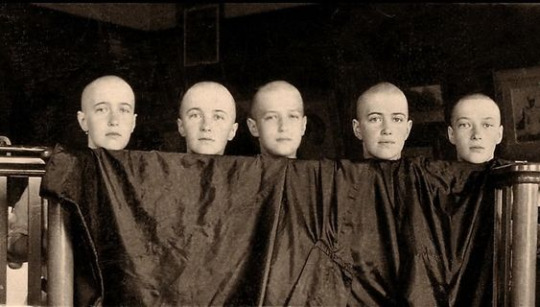
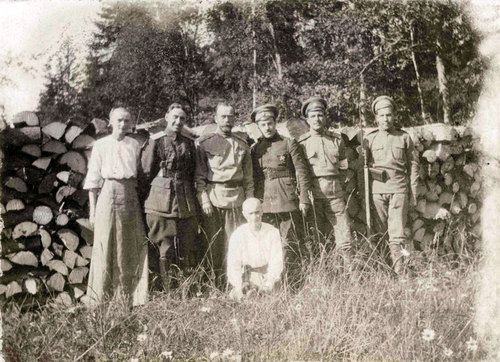
Personally, I also don't enjoy 'Four Sisters'. Helen Rappaport sadly put quite a few misconceptions and outright lies into her books, so her quoting from a very unreliable source doesn't surprise me sadly.
I also want to add that despite being a little harsh here about her memoirs, Maria Rasputina was a fascinating woman. She actually worked as a lion tamer in a circus for a few years, and there's a video of her doing this which you can see here. She ended up being mauled by a bear whilst working for the circus, but continued working with the company and advertising herself as the performing 'daughter of the mad monk'. She also claimed she was psychic and held seances. She needs her own book about her!
#Tatiana Romanov#Tatiana Nikolaevna#Romanovs#Romanov sisters#1913#Maria Rasputina#Matryona Rasputina#Rasputin#Grigori Efimovich Rasputin#wigs#hair#my own#myths#Helen Rappaport#books
36 notes
·
View notes
Text
What Does Rasputin Have to Do With the ‘This Is a Work of Fiction’ Movie Disclaimer?
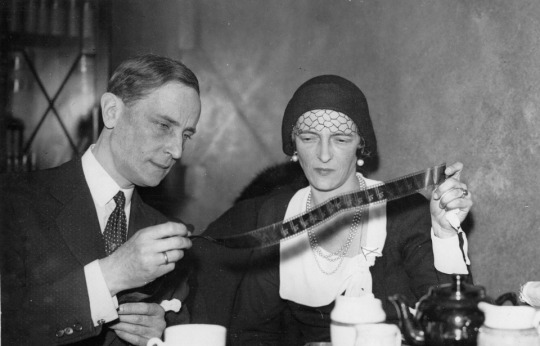
Photo Credit: Imagno/Getty Images)
What on earth could Rasputin have to do with that ‘fictional’ disclaimer before films? Well, a lot, actually. It is because of his life and death that production studios are terrified of being sued for defamation and want to make sure that audiences know what they are presenting should not be taken as historical fact – even if it is. Metro-Goldwyn-Mayer (MGM) steered a little too far from the truth and it cost them dearly. It was a mistake that many production companies have since tried to avoid.
The Death of Rasputin

Grigori Efimovich Rasputin, Russian mystic, spiritual advisor to the Romanovs, and a highly influential figure in the court of Tsar Nicholas II, circa 1905. (Photo Credit: Hulton Archive/Getty Images)
As history books tell us, Rasputin was difficult to kill. His eventual demise came at the hands of Prince Felix Yusupov, who was married to the tsar’s niece, Princess Irina Alexandrovna. Yusupov, along with other disgruntled aristocrats, devised a plot to get rid of the mystic who had grown too close for comfort to the Russian Imperial Family.
Their first attempt was unsuccessful. In 1916, Rasputin had been invited to Yusupov’s palace where they had laced cakes with cyanide. Strangely enough, the poison seemed to have no effect on the mystic. Later that evening, Yusupov resorted to shooting Rasputin with the help of fellow aristocrat Vladimir Purishkevich, who followed up with four shots to his back.

Grigory Yefimovich Rasputin – peasant, mystic and self-styled holy man, who had a magnetic influence over Alexandra and her husband, Tsar Nicholas II is in the midst of a group of his followers, circa 1911 (Photo Credit: Topical Press Agency/Getty Images)
As punishment for his crime, the tsar exiled Yusupov and his wife, Princess Irina, from the country without a penny to their name. They moved to Paris, which, unbeknownst to them and the tsar, would keep them from being killed alongside the rest of the Imperial Family in the Russian Revolution.
MGM Came Out with a New Film

Movie poster for the 1932 film, Rasputin and the Empress (Photo Credit: Metro-Goldwyn-Mayer/MovieStillsDB)
In 1932, MGM made a film titled Rasputin and the Empress that involved the killing of Rasputin. This film was expected to be a hit, as MGM was able to hire all three of the Barrymore siblings (who were huge stage and silent film actors) to star as the main characters. Lionel was Rasputin, Ethel was the tsarina, and John was “Prince Paul Chegodieff.” This film was the first (and only) time all three starred in the same film together, so it was a pretty impressive cast that was sure to draw in large crowds.
In the film, Prince Paul Chegodieff’s wife, Natasha, is a supporter of Rasputin. Rasputin was not trusting of Chegodieff and uses his wife to attack him. Rasputin places Natasha under a hypnotic spell and assaults her so that she admits she is no longer fit to be a wife. The film made it very obvious that Prince Paul Chegodieff was a representation of Yusupov, which naturally made Natasha a representation of his wife, Irina. They even made Natasha the same age and dressed her in a gown that looked oddly similar to one Irina had once worn.
MGM was really excited about the plot they had come up with. They found it a lot more interesting and believed audiences would too. There was one skeptic, however, a researcher for the company, who warned them that the factual discrepancies between the film and real-life could cause them a lot of trouble. Not heeding this warning, they fired her and went on with the film.
The Lawsuit

Prince Felix Yusupov, with his wife Princess Irina, granddaughter of Tsar Alexander III, circa 1934 (Photo Credit: Sasha / Hulton Archive/Getty Images)
After they were exiled, Yupurov had written a memoir about his crime, since he was very proud of having killed Rasputin. Unfortunately for him, this memoir prevented him from coming forward with a libel case against MGM after hearing the plot of the film. As he was the one to actually commit the murder, that information was not necessarily presented as false by the production company. What was presented as false was the depiction of Irina as Natasha. Irina had never met Rasputin, so the idea that her character in the film not only met and supported him but was hypnotized and raped by him was clear defamation of her reputation. So she sued.
MGM made the mistake of prefacing the film with a statement that basically told audiences to trust the film as historical fact. They said, “This concerns the destruction of an empire… A few of the characters are still alive – the rest met death by violence.” Considering that Yusupov and his wife were the only two surviving members of the Imperial court, it was not difficult for people to deduce that Prince Paul was Yusupov and Natasha was Irina. At this point, MGM had done virtually nothing to protect themselves against this lawsuit, and Irina won the case, receiving £25,000 ($2.4 million by today’s standards). The film was taken out of circulation for years and unsavory scenes were removed from the film as further punishment.
A Disclaimer Would Suffice

A title card from the film Affairs of Cappy Ricks (1937) showing an ‘all persons fictitious’ disclaimer (Photo Credit: Public Domain)
The justice of the case had actually mentioned that if they’d presented a disclaimer that did the exact opposite of what their original one had, they would have stood a much better chance in court. That was the slap on the hand MGM needed to make sure they were protected from further lawsuits. From then on, they placed a disclaimer at the beginning of every film stating that what they presented was fiction and should not be taken as fact in any way.
They weren’t the only production company to do so. The lawsuit lost by MGM cost them a pretty penny, and fellow studios did not want to risk that happening to them. Soon, every film had a disclaimer at the beginning reminding the audience that what they were about to watch was not real. Even films that were fact, like Jake LaMotta’s biopic Raging Bull, were labeled as entirely fictitious although, in this case, the man himself and his memoir are cited as consultants on the film.
No one was taking any chances with libel cases. It was only after Yusupov died in 1967 that studios began to ease up on using the disclaimer before every film. Still, you often see it today.
— Published by Samantha Franco in Instant Articles, Strangeness, Vintage Hollywood
12 notes
·
View notes
Photo

#rasputin#grigori rasputin#r. j. minney#biography#non fiction#hardback#1970s#grigori efimovich rasputin#russia#the mad monk#siberia#portrait#hbc#history book club
8 notes
·
View notes
Photo



Rasputin (1869 - 1916)
Григорий Ефимович Распутин
RUSSIA - 1914: Grigori Rasputin poses for a photograph on his hospital bed some time after he was injured during an assassination attempt on his life on June 29 (O.S.), 1914 in Russia. (Photo by Laski Diffusion/Getty Images)
Post-mortem photo of Grigori Rasputin taken before his autopsy on December 20 (O.S.), 1916, Saint Petersburg. Part of a police dossier on Rasputin's death. (Photo by Wojtek Laski/Getty Images)
Sometime over the course of the night and the early morning of December 29-30, 1916, Grigory Efimovich Rasputin, a self-proclaimed holy man, is murdered by Russian nobles eager to end his influence over the royal family... - This Day in History
Alexandra Feodorovna (1872- 1918)
Empress consort of Russia, photographed by Boasson and Eggler, 1908
Much of Rasputin's influence stemmed from Alexandra Feodorovna’s belief that he could stop the bleeding of hemophilia... Granddaughter of Queen Victoria (UK), Alexandra was, like her grandmother, one of the most famous royal carriers of the haemophilia disease. The last Romanov Empress had lost her elder brother, Prince Friedrich of Hesse and by Rhine and her uncle, Prince Leopold, Duke of Albany to hemophilia, and bore a hemophiliac heir, Alexei Nikolaevich, Tsesarevich of Russia.
#Rasputin#villains#Russia#history#Hospital#Handwriting#politics#decadance#Romanov#revolution#execution#death#DNA#medical#fake#Queen
16 notes
·
View notes
Text

The petition addressed to Tsar Nicholas II by some of his relatives, on behalf of Grand Duke Dmitri Pavlovich Romanov of Russia after he had been banished into exile for taking part in murder of Grigory Efimovich Rasputin.
"Your Imperial Majesty. We all whose signatures You will read at the close of this letter, fervently and strongly implore You to mitigate Your severe decision concerning the destiny of Grand Duke Dmitri Pavlovich. - We know that he is physically sick and morally. You, - his former Trustee and Supreme Guardian, know his heart has always been filled with so much fervent love for You, Your Majesty, and for our Motherland. We entreat Your Imperial Majesty, in view of the young age and really poor health of the Grand Duke Dmitri Pavlovich to allow him to stay in Usov or lyinskoye. Your Imperial Majesty must be aware of how hard are the conditions for our troops in Persia, because of lack of living quarters, epidemics and other scourges of the human race, should Grand Duke Dmitri Pavlovich be obliged to stay there, it would mean his complete ruin and in the heart of Your Imperial Majesty, thre must emerge some pity for the youth whom You have loved, who since childhood has been happy to be m uch and often near You and to whom You have been as kind as a father. May the Lord Exhort Your Imperial Majesty to change your decision and temper justice with mercy. Fervently faithful to and fondly loving Your Imperial Majesty
Olga (Konstantinovna)
Maria (Pavlovna the Elder)
Kyril (Vladimirovich)
Victoria (Fyodorovna)
Georgiy (Mikhailovich),
Andrei (Vladimirovich)
Pavel (Alexandrovich)
Maria (Pavlovna the Younger)
Elizaveta Mavrikievna
loann (Konstantinovich)
Elena (Petrovna)
Gavril (Konstantinovich)
Konstantin (Konstantinovich)
Igor (Konstantinovich)
Nikolai Mikhailovich
Sergei Mikhailovich.
In reply Nicholas returned the letter, writing on top of it:
" Nobody has got the right to commit an assassination. I know that many are conscience stricken, for not only Dmitri Pavlovich is implicated in the crime. Your application surprises me.
Nicholas. "
3 notes
·
View notes
Photo

Rasputin
His name was Grigori Efimovich Rasputin and he is one of the most enigmatic men in modern history. Was he a misunderstood holy man with strange powers to heal - or was he a scheming sinner who manipulated the suffering of others?
Rasputin was born in the Tyumen district of Siberia, far away from the glittering salons in the Imperial Capital of St. Petersburg. Even today he is a shadowy and mysterious character; a person of contradictory personality traits. While he was alive, witnesses, including doctors and skeptics, concluded he possessed some inexplicable power over the Tsarevich and his deadly episodes of bleeding. This mysterious ability to heal her son was enough to convince Alexandra that Rasputin, whatever people said of him, must have been sent by God. In her mind he was he the answer to her fervent prayers for God to save her son. It was impossible for her to believe that he could have been a wolf in sheep’s clothing. His influence over politics has been greatly exaggerated. Rasputin was a convenient scapegoat for those who wanted to attack the Tsar’s appointments and decisions, but who wouldn’t confront Nicholas directly.
Rasputin was close to the Tsaritsa’s closest friend, Anya Vyrubova. Her devotion to him was absolute, which was reinforced after a terrible derailment of the train from Tsarskoe Selo to Petersburg in which Anna was almost killed. Although she survived the accident Anna’s condition was so bad her doctors despaired of saving her life; her body was crushed and mangled. Rasputin came to her bedside, stood over Anna as she lay near death. He reached out and held her hand. Dripping with sweat, intensely focused, Rasputin repeated the words, “Annushka, Annushka, rise!”. The drama of the moment was incredible. Anna suddenly awoke from her coma, opened her eyes and tried to rise from her bed. It was a miracle. As Rasputin staggered into the next room, he spoke, prophetically saying that although she would live, for the rest of her life Anna would be a cripple. So it came to be.
Rasputin tried to ingratiate himself with other members of the Romanov family, but most of them would have nothing to do with him. Olga, Nicholas sister, resented Rasputin’s prying into her private life and rebuffed his offers of spiritual help in her marital problems.
A number of influential churchmen fell for Rasputin early in his ‘career’ as a holy man. Later, these supporters in the church hierarchy turned on him and attempted to send him away from St. Peterburg. Rasputin cunningly knew how to undermine his enemies in the church and soon had them exiled or in disgrace. A bishop or monk who opposed him might find them self suddenly sent to a remote monastery or far-away episcopal see. In government affairs Rasputin’s power was an illusion, although the Petersburg press crowed about his influence over important government appointments. Gossip claimed he had seduced the Empress, her daughters, and Anna Vyrubova as well. These rumors, which reached the highest circles of society where they were deliciously repeated by Alexandra’s foes, drove Nicholas to distraction. The remoteness and isolation of the Imperial Family made it possible for the general public to believe these crazy stories, but the aristocracy knew they were groundless. Still they derived pleasure from seeing Alexandra’s named dragged through the mud. Rasputin made the talk worse by flaunting the Imperial families gifts, letters and the telephone calls he received from Alexandra asking for his prayers. People believed he had an uncanny control over the Tsar and his wife. Rasputin enjoyed the celebrity status this reputation gave him.
The story of Rasputin’s demise is well known. One night in December 1916, Rasputin was invited by Prince Felix Felixovich Yussupov to visit his palace on the Moika Canal. The pretext was the opportunity for Rasputin to meet Felix’s wife, Irina, who was a great beauty and niece of the Tsar. Rasputin wanted to meet Irina and was flattered by Felix’s attention. Felix claims he had been nurturing a relationship with Rasputin for a number of years before the invitation, although this relationship has never been fully explained. Felix always portrayed his murder of Rasputin as a political act to save Russia.
Certainly, Felix had never shown any patriotic leanings before, so his murder of Rasputin is hard to explain from a political standpoint. It may have been there was some other, more personal, reason for Felix’s desire to get rid of him. Besides Felix, who was the mastermind of the plot, the Tsar’s first cousin and ward Grand Duke Dmitri Pavlovich Romanov, and a member of the Imperial Duma, Vladimir Mitrofanovich Purishkevich, were also involved in Rasputin’s killing.
10 notes
·
View notes
Text
Sepak terjang Rasputin, Dukun cabul dengan kemaluan sepanjang 30 Cm. Rasputin termasuk manusia yang paling sukar dimengerti dalam sejarah modern. Sebagai manusia suci, Rasputin memiliki kemampuan menyembuhkan penyakit. Rasputin diangkat sebagai penasehat spiritual sang raja alias dukun politik. Dia kemudian menggunakan kekuasan untuk hal-hal jahat. Puluhan istri maupun gundik pejabat negara dikencani. Beberapa perempuan malah rela menyerahkan kehormatannya karena sang Rasputin dikenal memiliki penis sepanjang 30 cm. Gejolak pun timbul. Rasputin dimusuhi banyak orang. Dia dibunuh. Penisnya dipotong dan dijadikan tontonan.
0 notes
Text
History
December 30
1903 - Iroquois Theatre Fire, Chicago, Illinois - over 600 people were killed.
1916 - Grigory Efimovich Rasputin was murdered. He was a family friend and confidant of Russia's Czar Nicholas II and Czarina Alexandra.
1922- Russia, Belorussia, Ukraine, and the Transcaucasian Federation formed the USSR (Union of Soviet Socialist Republics).
1948 - The Cole Porter Broadway musical, Kiss Me, Kate (1,077 performances), opened at the New Century Theatre. It was based on Shakespeare's play The Taming of the Shrew.
1953 - The Wild One, starring Marlon Brando was released.
1968 - The Gonzaga '68 bootleg was recorded at a western Washington State gym. The music was of the opening act, Vanilla Fudge, and was one of the earliest performances by Led Zeppelin. They were locally advertised as 'Len Zefflin.'
1993 - Israel and Vatican City establish diplomatic relations.
1994 - Anti-abortionist John Salvi III killed two people and injured five more at an abortion clinic in Brookline, Massachusetts.
0 notes
Text
admin & # 039; s Galleries
Hans Richter. A journey through a century
As part of the exhibition, the Center Pompidou-Metz commissioned photographer Yann Arthus-Bertrand to make a bird's-eye view of a film about Metz and the surrounding area, which will be shown in the exhibition from June. This project was financed by the Metz Métropole community (surrounding area). While the pre-war urban representations were determined by the dynamics of the vertical cityscape, the proliferation of urban fabric, which, like in the case of Los Angeles, dissolves into an abstract network of unoccupied traffic flows, became a subject for artists in the late 1960s Ed Ruscha. In contrast to abstract, conventional maps, these cartographic sketches show actions that result from an experience or a distance. They have arisen from locomotion and result from the detection of currents or directions. The traces drawn are the changing lines of a flexible, subjective geography, illustrated stories that give rise to an inhabited territory. It was only in the second half of the 19th century that the dunes could be planted and stabilized. True to its cultural purpose, which includes exhibiting public collections, iphone 11 bazooka phone case , the Center Pompidou-Metz invites FRAC Lorraine to celebrate the 30th anniversary of the creation of the FRAC (Regional Fund for Art Contemporain - Regional Collections of Contemporary Art).
Catalogo Vino Nicolas 1963 Lista Grandi Vino da Bernard Buffet Corrida
On December 30, 1916 (according to the Gregorian calendar), the dazzling wandering preacher and miracle healer Grigori Efimovich Rasputin was murdered. The humanitarian organization was founded 40 years ago and works tirelessly for people in need every day. Comment Not only Camille Claudel, but also the Mexican muralist or "muralist" Diego Rivera had his birthday on December 8th (1886). On November 2nd, 2006 we were able to toast with our customers and partners on the new business premises at Laupenstrasse 35. Gendarme or man in armor, from the 15th century. The New Year's Eve tour is now the turn of the year, with a little festivity in the camp, a special dinner and later a romantic campfire with sparklers and toasts at midnight. I fill the first champagne glass and call Max to toast with him over the phone. LingueeFind reliable translations of words and phrases in our comprehensive dictionaries and search billions of online translations. Book one of the many activities with local hosts on your next trip. The exhibition Frac Forever is created in collaboration with the FRAC Lorraine. February 2014 on wipplay.com. You can follow him on the Facebook page of the Center Pompidou-Metz. By changing information about cycling, you agree to its use.
0 notes
Text
Romanov myths part three - did the Grand Duchesses go shopping?
Over the years, a prevalent belief that the Romanov Grand Duchesses, Olga, Tatiana, Maria, and Anastasia did not go shopping continues to be repeated. Some historians have even suggested that the girls did not know how paying for items worked. However, primary sources from people who knew the girls, were members of their entourage, and the Grand Duchesses' own diaries, tell a different story...
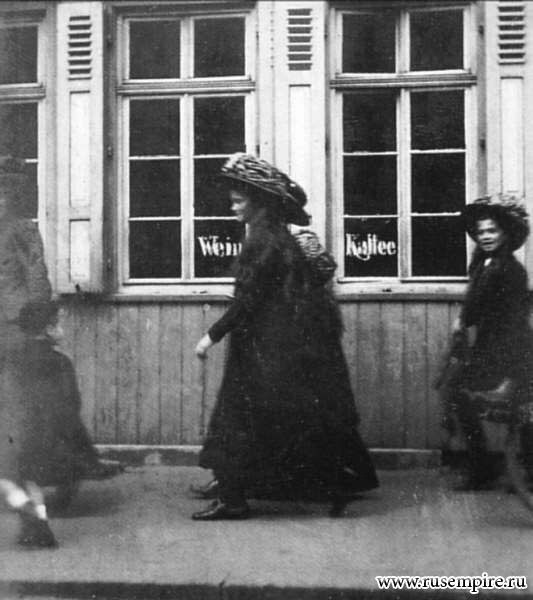
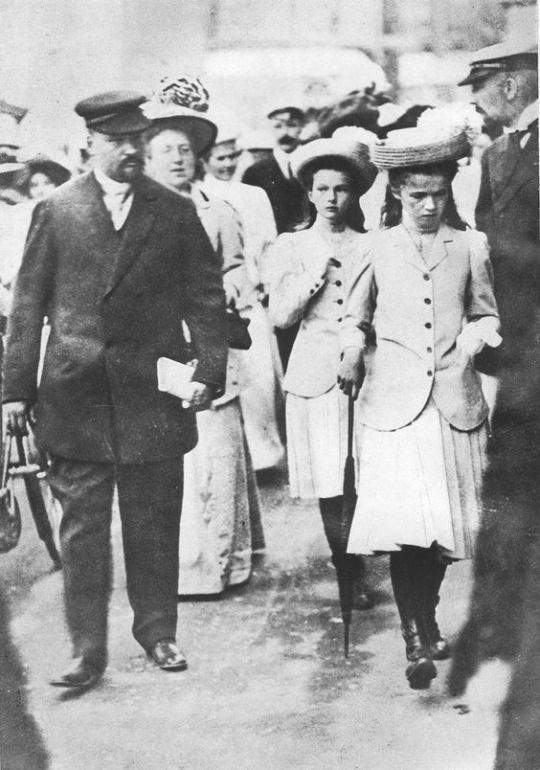
"Saturday. 10 August. … We walked along the historic boulevard and the main streets, but crowds followed us everywhere, so we were able to go into only 2 shops for a minute..."
"Friday. 15 November. Had lessons, after that went shopping for wool with Nastenka as usual.."
From Grand Duchess Olga Nikolaevna’s 1913 diary [my underlining]
In this entry, Olga describes shopping Countess Anastasia 'Nastenka' Vassilievna Hendrikova, who was a young lady-in-waiting at court and a particular favourite of the Grand Duchesses, often accompanying them on trips. As described in the first entry, it appears that safety and security concerns due to crowds, rather than a lack of understanding about shops, contributed to the Grand Duchesses not being able to shop frequently. Nastenka is frequently mentioned by the Grand Duchesses in their diaries, and volunteered to join the Romanov family in their house arrest and imprisonment. She was murdered by the Bolsheviks in September 1918.
"After coffee, I went for a walk with my pupils… They really liked to go to the shops and buy everything. Anastasia Nikolaevna was especially attracted to stores, where they sold doll shoes of various sizes… Tatiana Nikolaevna did not always accompany since the doctors found her heart was weak and she went with the Empress to take baths."
A Few Years Before the Catastrophe by Sofia Ivanovna Tyutcheva.
Sofia Ivanovna Tyutcheva was a maid-of-honour to Tsarina Alexandra Feodorovna, and in 1907 was appointed as governess to the Grand Duchesses. The Grand Duchesses referred to her as "Savanna". She was dismissed in 1912 when she voiced concerns over Grigori Efimovich Rasputin. She wrote a short memoir in 1945, and passed away in 1957.

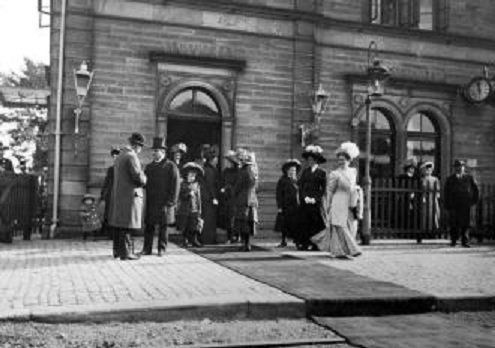
"[The] Grand Duchesses went shopping in the morning with one of the ladies-in-waiting to the Empress. They delighted in that because they could mix with the crowd and buy things just as everyone else did, and they were so pleased if they were not recognised at once." -- Upheaval - Olga Voronova
Countess Olga Konstantinovna Voronova was part of the aristocratic Kleinmichel family and in 1914, married one of the Romanov's favourite officers, Pavel Alexeievich Voronov. Through these connections, Olga Konstantinovna became a friend of the Grand Duchesses, exchanging frequent letters with Olga and Tatiana in particular, before and after the Revolution. She published her memoirs in 1932. Once again, it is inferred that being recognised and subsequent security concerns stifled the Grand Duchesses' shopping sprees.
Where did the myth come from?
It appears that the myth came about due to this extract from Margaretta Eagar, an Irish nanny who cared for the children from 1898 to 1904:
Her only knowledge of shops and shopping was derived from the toy and sweet shops in Darmstadt. One day she asked me why the Americans spoke English, not American. I told her the story of the Pilgrim Fathers, and described how they built houses and shops, and so made towns. She was exceedingly interested and inquired, ' Where did they find the toys to sell in the shops ? "
Six Years at the Russian Court, by Margaretta Eagar
It appears that some historians forgot that Margaretta Eagar moved on from her nanny position in 1904, when the eldest Grand Duchess was nine and the youngest was three, and perhaps did not look for sources from when the Grand Duchesses had grown up and had slightly more independence.
Over time, the myth appears to have been exaggerated and repeated until it became part of the 'folklore' surrounding the Romanov Grand Duchesses.
Whilst it is clear that the Grand Duchesses did enjoy going shopping in their lifetimes, safety and security concerns meant they could not enjoy shopping as frequently as other teenagers may have. In the same way royals today would not be able to go to shops without being recognised, there was a chance that a crowd could gather. Similarly, Olga and Tatiana appear to have shopped more than the younger pair, Maria and Anastasia, likely due to being older in age and therefore having more independence.
Photos:
First set, left: Olga, Anastasia (hidden behind Olga), and Maria Shopping in Germany, 1910. Right: Olga and Tatiana out shopping in the Isle of Wight, 1909, accompanied by Dr. Evgeny Botkin (in the suit)
Second set, left: Tatiana and Maria shopping with Sofia Ivanovna Tyutcheva, circa 1910. Right: The Grand Duchesses and their entourage by shops, most likely taken in Germany, 1910
Sources:
Journal of a Russian Grand Duchess: Complete Annotated 1913 Diary of Olga Romanov, Eldest Daughter of the Last Tsar, translator Helen Azar, (Independently published: 2015)
A Few Years Before the Catastrophe: The Memoirs of Sofia Ivanovna Tyutcheva, translator George Hawkins, (Independently published: 2020)
Upheaval, Olga Voronova (Woronoff), (New York; London: G. P. Putnam's Sons, 1932) -- Free to read online here
Six Years at the Russian Court, Margaretta Eagar, (New York: Charles L. Bowman and Company, 1906) -- Free to read online here
#Romanov#Romanov family#otma#Olga Nikolaevna#Tatiana Nikolaevna#Maria Nikolaevna#Anastasia Nikolaevna#sources#myths#myth-busting#Romanov sisters#Margaret Eagar#Margaretta Eagar#Sofia Ivanovna Tyutcheva#Nastenka Hendrikova#diaries#free to read#Olga Romanov#Tatiana Romanov#Maria Romanov#Anastasia Romanov
86 notes
·
View notes
Link
Mariya Naglovskaya, conocida en Europa occidental como Maria de Naglowska, nació en el seno de una familia aristocrática de San Petersburgo en 1883. Su padre, un general que había combatido contra los turcos en los Balcanes y había llegado a gobernador en Kazán, fue envenenado durante una partida de cartas por un nihilista que había logrado granjearse la confianza de la familia. La madre murió también poco tiempo después, cuando Maria contaba sólo doce años. Su principal biógrafo, Pluquet, escribiría sobre ella en aquellos días: "Su salud era frágil y tuvo una infancia difícil, pero sorprendía a los que la rodeaban por sus opiniones mordaces y su comportamiento razonable pero imprevisible".
Al quedar huerfana, fue enviada por sus parientes como interna al elitista Instituto Smolny de San Petersburgo, un centro reservado a muchachas de la nobleza rusa, donde obtuvo notables calificaciones, y luego pasó a vivir con una de sus tías. Interesada por las ideas que agitaban Rusia en aquella época, frecuentó por su cuenta los ambientes intelectuales, artísticos y políticos de la entonces capital del Imperio Ruso. Entre las personas que conoció en aquellos años se encontraba un célebre y escandaloso personaje que había llegado a la ciudad bajo la protección especial de los propios zares: Grigori Efimovich Rasputin. Maria traduciría años después una biografía de él al francés.
Durante su estancia en el Instituto Smolny, cuando tenía dieciséis años, pasó unas vacaciones en un castillo que la familia poseía en el Cáucaso. Durante ellas tuvo su primer contacto con los rituales sexuales. En su libro El Rito Sagrado del Amor Mágico describió de manera novelada esta experiencia. Un joven cosaco que estaba enamorado de ella la llevó a una reunión secreta de la secta khlysti, donde ambos hicieron el amor mientras los presentes los rodeaban ceremonialmente y homenajeaban sus órganos sexuales.
Durante un concierto en San Petersburgo, Maria se enamoró del violinista de la orquesta, Moise Hopenko. Su familia se opuso a esta relación porque ella era aristócrata y ortodoxa, y él plebeyo y judío. Maria y Moise decidieron entonces marcharse juntos de Rusia. Se establecieron primero brevemente en Alemania, en Berlín, y luego en Suiza, en Ginebra. En este tiempo nacieron sus dos primeros hijos, Alexandre y Marie. En Ginebra Maria fundó una escuela para universitarios rusos que tenían dificultades con el idioma francés y ella misma se matriculó en distintas materias en la universidad. Pero la escuela no fue bien y Maria tuvo que acabar dando clases en academias particulares. Con el dinero que ella obtenía con no poco esfuerzo, Moise se enfrascó totalmente en sus estudios musicales. Cierto tiempo después Moise conoció a Theodor Herzl, el padre del sionismo, y abrazó de forma entusiasta esta ideología política. Abandonó a Maria, entonces embarazada de su tercer hijo, André, y se marchó solo a las colonias que los sionistas estaban creando en Palestina. Poco después sería nombrado director del conservatorio de música de Tel Aviv.
Maria se quedó en Ginebra y consiguió con su trabajo como profesora en distintas escuelas privadas contratar a una niñera que la ayudara en el cuidado y la educación de sus hijos. Así pudo retomar su vida pública y participar en los círculos culturales de la ciudad. Una conferencia contra la guerra mundial que impartió en la sala de la Sociedad de Artistas en 1918 condujo a que las autoridades de Ginebra consideraran que había violado la prohibición para los extranjeros de dedicarse a actividades políticas, y fue encarcelada. Una campaña en la que participaron ciertas personas influyentes de la ciudad consiguió su liberación, aunque no evitó que fuera oficialmente expulsada del cantón de Ginebra. Sin apenas medios, se trasladó a Berna, que también la expulsó, y luego a Basilea, donde no encontró forma de mantenerse. Maria decidió entonces pedir la ayuda de Moise Hopenko para el cuidado de sus hijos, pero éste sólo aceptó acoger en Tel Aviv a Alexandre, el mayor. Los otros dos, Marie y André, debieron quedar al cuidado de la asistencia social suiza.
Buscando el modo de subsistir, Maria se trasladó a Roma, donde un amigo suizo le había ofrecido alojarse en un apartamento que poseía en la ciudad. Allí volvió a dar clases particulares y escribió algunos artículos periodísticos. Consiguió reunir los fondos para traer a Italia a sus dos hijos menores, que se habían quedado en Suiza. Con el tiempo, André comenzó a trabajar en un hotel y luego partió también a Oriente Medio a vivir con su padre. La hija, Marie, empezó los estudios de enfermería. Pero los problemas económicos no cesaron: el amigo suizo que le había cedido su apartamento se suicidó, y Maria se encontró sin un techo fijo en la ciudad. A pesar de estas dificultades, frecuentó los círculos ocultistas romanos, en los que conoció a Julius Evola y a quienes con él constituían el llamado Grupo de Ur. El grado de relación personal entre Naglowska y Evola sigue siendo un tema controvertido para sus respectivos biógrafos. Evola se referiría posteriormente a Naglowska y a sus teorías sobre la magia sexual en su libro Metafísica del Sexo, y también colaboraría con un artículo ("Occidentalismo") en el primer número de la revista que ella fundaría unos años más tarde en París. Maria afirmaría haber entrado en contacto también en Roma con un misterioso ruso exiliado que le transmitió determinadas enseñanzas secretas boreales o polares, posiblemente relacionadas con la tradición ocultista que en Alemania desarrollaba por su cuenta la Fraternitas Saturni. Es sabido que en Roma Maria redactó, aunque no publicó, los fundamentos de su teoría de la magia sexual oscura y que dirigió ciertos rituales colectivos en esta línea, en los que seguramente tomó parte el mismo Evola.
Mientras tanto el hijo mayor de Maria, Alexandre, se había trasladado de Tel Aviv a Alejandría y había alcanzado una buena posición económica allí. Alexandre invitó a su madre a reunirse con él en Egipto. Maria se estableció en Alejandría e impartió diversas conferencias en la Sociedad Teosófica de la ciudad, llegando a ser muy célebre entre los miembros de la colonia europea interesados por el esoterismo. Se casó de nuevo brevemente con un ingeniero suizo empleado en la sociedad de tranvías de Alejandría. Algún tiempo después regresó a Suiza con su marido y más tarde, ya divorciada, de nuevo a Italia. Los ahorros que traía de Alejandría comenzaban a agotarse y sus amigos romanos lograron encontrarle en 1929 un puesto en una editorial de París.
Sin embargo las autoridades francesas solicitaron informes sobre ella a la policía suiza y reapareció el incidente de su encarcelamiento y expulsión de Ginebra. Tras varios meses en París esperando tener sus papeles en regla, recibió la noticia de que se le denegaba el permiso de trabajo en Francia. De nuevo en la penuria económica, decidió afincarse en el barrio de Montparnasse, el gran centro de la bohemia artística y cultural de la ciudad. Procurándose los medios de subsistencia prácticamente de día en día, se alojó en una modesta casa de huéspedes del barrio y reinició su actividad pública en los cafés cercanos. Una mesa del café La Rotonde —frecuentado por Diego Rivera y Pablo Picasso— le servía unas horas al día de escritorio y de oficina para recibir visitas. En el café La Coupole ocupaba regularmente el fondo de uno de los salones para dar sus conferencias, un lugar que los dueños del establecimiento ya llamaban "el rincón de los ocultistas". Al final de cada conferencia, que congregaba alrededor de unas treinta o cuarenta personas, La Coupole le daba gratis de cenar, además de cobrarle sólo la propina de los cafés que tomaba. Posteriormente, al contar con la ayuda económica de su hijo André, las charlas se trasladaron al más íntimo Studio Raspail, un local que alquilaba semanalmente. La asistencia a los actos, que se celebraban todos los miércoles a las nueve de la noche, costaba unos dos francos. Por estas reuniones y conferencias pasó lo más célebre de la intelectualidad creativa e inconformista de París: Ocultistas, clarividentes, surrealistas, dadaístas, vanguardistas y revolucionarios de toda índole. Aunque naturalmente no hay constancia de los nombres de los asistentes, la huella de Naglowska se reconoce en las tesis sobre la "Ciudad Radiante" de Le Corbusier, en la "Sociedad del Acéfalo" de Georges Bataille, en las nuevas concepciones fotográficas de Man Ray, en las formas de relacionarse con los hombres de Gala Dalí... Cuando en febrero de 2016 la Academia de Bellas Artes de Roma apadrinó el encuentro internacional sobre el primer centenario del movimiento Dada, decidió dedicar su monográfico impreso precisamente a la vida y la obra de Maria de Naglowska.
Portada del primer número de La Flèche (1930).
El trabajo de Maria en aquellos años en París no sólo consistió en sus conferencias semanales. Fue la época en que puso en práctica sistemáticamente sus doctrinas en forma de rituales colectivos y en que dejó por escrito sus ideas. Desde 1930 hasta 1935, un año antes de su muerte, publicó veinte números de una revista, La Flèche, subtitulada "Órgano de Acción Mágica". La Biblioteca Nacional de Francia conserva ejemplares del número 1 y de los números 5 al 20 de esta publicación realmente difícil de encontrar hoy en día. En La Flèche, con su propio nombre o con el pseudónimo de "Xénia Norval", publicó por entregas o en suplementos monográficos sus principales obras: La Lumière du Sexe [La Luz del Sexo] y Le Rite Sacré de l'Amour Magique [El Rito Sagrado del Amor Mágico], ambos en 1932, y Le Mystère de la Pendaison. Initiation Satanique [El Misterio del Ahorcamiento. Iniciación Satánica], en 1934. A estas obras hay que añadir su "traducción" del célebre libro Magia Sexualis, atribuido al norteamericano Paschal Beverly Randolph, publicada en 1931. La mayoría de los estudiosos considera hoy que esta obra, un hito fundacional de la magia sexual en Occidente, pertenece en parte o en todo a la propia pluma de Maria de Naglowska. El supuesto texto original inglés nunca se ha encontrado —las versiones inglesas hoy existentes son traducciones desde la edición francesa. Maria relataba haber recibido de forma rocambolesca el manuscrito de manos de una misteriosa figura que se le acercó en una calle de París y luego desapareció. Tal parece que Naglowska publicó esta obra con el nombre de Randolph por razones similares a las que, en una sociedad que sólo reconocía la voz de los hombres, Aurore Dupin decidió firmar sus escritos como "George Sand", o Cecilia Böhl como "Fernán Caballero". De hecho Magia Sexualisalcanzó una fama y un reconocimiento internacional que excedió en mucho las otras obras editadas por Naglowska, pese a que muchas de sus tesis y prácticas estuvieran ya esbozadas en otros trabajos de esta autora.
Las ideas de Naglowska sobre la magia sexual giraban en torno a lo que ella designaba como T.T.T. (Tercer Término de la Trinidad, o del Triángulo). Consideraba que se podía representar la historia de la cultura europea en la forma de un "triángulo temporal" con dos lados claros y uno oscuro. Este triángulo solía presidir el altar durante la celebración de sus rituales de iniciación. Su primer lado claro simbolizaba al Judaísmo, cuya personificación o hipóstasis era la figura del Padre, su signo la Vara y su "antorcha" la Ley. El segundo lado claro representaba al Cristianismo, cuya personificación era la figura del Hijo, su signo la Cruz y su "antorcha" el Corazón. Estos dos lados claros habían ocupado juntos un total de cinco mil años de patriarcado. El tercer lado del triángulo seguía históricamente a los otros dos y era el lado oscuro de Satán o Lucifer, el lado matriarcal. Su personificación era la Mujer, su signo la Flecha y su "antorcha" el Sexo. "Cristo sostiene todavía la tesis de la pureza en la castidad, mientras Satán preconiza la luz reencontrada en la carne", escribió. Esta nueva etapa satánica se había iniciado formalmente a comienzos de 1933, aunque ella era consciente de que sus enseñanzas no serían acogidas hasta bastantes generaciones más tarde, después de que la conciencia de Europa hubiese sido agitada por terribles acontecimientos, entre ellos una guerra mundial más atroz que la anterior.
Con sus seguidores, Naglowska puso en marcha en París la Fraternidad de la Flecha de Oro, ordenada por grados a los que se accedía mediante rituales sexuales específicos. En ellos la mujer ocupaba el papel central o sacerdotal, puesto que, según dejó escrito, "el sexo del hombre pertenece a Dios y el sexo de la mujer pertenece a Satán". Uno de ellos, la "Misa Dorada", es descrito así por Nicholas y Zeena Schreck:
"Unas veinte parejas copulaban formando una "cadena mágica" de modo muy parecido a las orgías circulares chakra-puja del Tantra. La corriente sexual generada por la energía erótica activada por este grupo se dirigía a menudo a la destrucción mágica de los enemigos, pero a diferencia de otros satanistas, Naglowska también usaba estas "operaciones diabólicas" colectivas para curar a miembros de su grupo. La idea de la magia sexual realizada para la gloria de Lucifer puede inspirar pensamientos de orgías salvajes y desenfrenadas, pero las operaciones de sexo en grupo de Naglowska consistían en ritos meticulosamente coreografiados y controlados. Una danza meditativa, similar a la euritmia y a los movimientos que Gurdjieff enseñaba a sus discípulos, formaba parte importante de estas "misas doradas" y precedía a la fase sexual de las operaciones."
En otro ritual importante, imprescindible para que los componentes masculinos de la Fraternidad pudieran acceder a los grados superiores, se practicaba una modalidad del llamado estrangulamiento erótico. Maria lo llamaba "el Misterio del Ahorcamiento", y consistía en que el candidato era ahorcado hasta casi la muerte mientras alcanzaba su clímax sexual. "Sólo quien supere el rito del ahorcamiento iniciático —escribió— podrá unirse correctamente a una mujer, porque, al haber conocido la indecible felicidad del placer satánico, no podrá perderse en su carne".
0 notes
Photo

Rasputin
any person who exercises great but insidiousinfluence.
Grigori Efimovich, 1871–1916, Siberian peasant monk who was very influential at the court of Czar Nicholas II and Czarina Alexandra.
0 notes
Photo

Sometime over the course of the night and the early morning of December 29-30, 1916, Grigory Efimovich Rasputin, a self-proclaimed holy man, is murdered by Russian nobles eager to end his influence over the royal family.
0 notes
Photo

Grigori Efimovich Rasputin
His name was Grigori Efimovich Rasputin and he is one of the most enigmatic men in modern history. Was he a misunderstood holy man with strange powers to heal - or was he a scheming sinner who manipulated the suffering of others?
Rasputin was born in the Tyumen district of Siberia, far away from the glittering salons in the Imperial Capital of St. Petersburg. Even today he is a shadowy and mysterious character; a person of contradictory personality traits. While he was alive, witnesses, including doctors and skeptics, concluded he possessed some inexplicable power over the Tsarevich and his deadly episodes of bleeding. This mysterious ability to heal her son was enough to convince Alexandra that Rasputin, whatever people said of him, must have been sent by God. In her mind he was he the answer to her fervent prayers for God to save her son. It was impossible for her to believe that he could have been a wolf in sheep's clothing. His influence over politics has been greatly exaggerated. Rasputin was a convenient scapegoat for those who wanted to attack the Tsar's appointments and decisions, but who wouldn't confront Nicholas directly.
Rasputin was close to the Tsaritsa's closest friend, Anya Vyrubova. Her devotion to him was absolute, which was reinforced after a terrible derailment of the train from Tsarskoe Selo to Petersburg in which Anna was almost killed. Although she survived the accident Anna's condition was so bad her doctors despaired of saving her life; her body was crushed and mangled. Rasputin came to her bedside, stood over Anna as she lay near death. He reached out and held her hand. Dripping with sweat, intensely focused, Rasputin repeated the words, "Annushka, Annushka, rise!". The drama of the moment was incredible. Anna suddenly awoke from her coma, opened her eyes and tried to rise from her bed. It was a miracle. As Rasputin staggered into the next room, he spoke, prophetically saying that although she would live, for the rest of her life Anna would be a cripple. So it came to be.
Rasputin tried to ingratiate himself with other members of the Romanov family, but most of them would have nothing to do with him. Olga, Nicholas sister, resented Rasputin's prying into her private life and rebuffed his offers of spiritual help in her marital problems.
A number of influential churchmen fell for Rasputin early in his 'career' as a holy man. Later, these supporters in the church hierarchy turned on him and attempted to send him away from St. Peterburg. Rasputin cunningly knew how to undermine his enemies in the church and soon had them exiled or in disgrace. A bishop or monk who opposed him might find themself suddenly sent to a remote monastery or far-away episcopal see. In government affairs Rasputin's power was an illusion, although the Petersburg press crowed about his influence over important government appointments. Gossip claimed he had seduced the Empress, her daughters, and Anna Vyrubova as well. These rumors, which reached the highest circles of society where they were deliciously repeated by Alexandra's foes, drove Nicholas to distraction. The remoteness and isolation of the Imperial Family made it possible for the general public to believe these crazy stories, but the aristocracy knew they were groundless. Still they derived pleasure from seeing Alexandra's named dragged through the mud. Rasputin made the talk worse by flaunting the Imperial families gifts, letters and the telephone calls he received from Alexandra asking for his prayers. People believed he had an uncanny control over the Tsar and his wife. Rasputin enjoyed the celebrity status this reputation gave him.
The story of Rasputin's demise is well known. One night in December 1916, Rasputin was invited by Prince Felix Felixovich Yussupov to visit his palace on the Moika Canal. The pretext was the opportunity for Rasputin to meet Felix's wife, Irina, who was a great beauty and niece of the Tsar. Rasputin wanted to meet Irina and was flattered by Felix's attention. Felix claims he had been nurturing a relationship with Rasputin for a number of years before the invitation, although this relationship has never been fully explained. Felix always portrayed his murder of Rasputin as a political act to save Russia.
Certainly, Felix had never shown any patriotic leanings before, so his murder of Rasputin is hard to explain from a political standpoint. It may have been there was some other, more personal, reason for Felix's desire to get rid of him. Besides Felix, who was the mastermind of the plot, the Tsar's first cousin and ward Grand Duke Dmitri Pavlovich Romanov, and a member of the Imperial Duma, Vladimir Mitrofanovich Purishkevich, were also involved in Rasputin's killing.
60 notes
·
View notes
Text
December History
December 30
1903 - Iroquois Theatre Fire, Chicago, Illinois - over 600 people were killed.
1916 - Grigory Efimovich Rasputin was murdered. He was a family friend and confidant of Russia's Czar Nicholas II and Czarina Alexandra.
1922- Russia, Belorussia, Ukraine, and the Transcaucasian Federation formed the USSR (Union of Soviet Socialist Republics).
1948 - The Cole Porter Broadway musical, Kiss Me, Kate (1,077 performances), opened at the New Century Theatre. It was based on Shakespeare's play The Taming of the Shrew.
1953 - The Wild One, starring Marlon Brando was released.
1968 - The Gonzaga '68 bootleg was recorded at a western Washington State gym. The music was of the opening act, Vanilla Fudge, and was one of the earliest performances by Led Zeppelin. They were locally advertised as 'Len Zefflin.'
1993 - Israel and Vatican City establish diplomatic relations.
1994 - Anti-abortionist John Salvi III killed two people and injured five more at an abortion clinic in Brookline, Massachusetts.
0 notes
Text
Maria, Anastasia, and Olga Nikolaevna with their mother Alexandra Feodorovna and Grigori Efimovich Rasputin

Most likely taken at Anna Vyrubova's house, circa 1907
#Olga Nikolaevna#Maria Nikolaevna#Anastasia Nikolaevna#Alexandra Feodorovna#Grigori Rasputin#Rasputin
22 notes
·
View notes